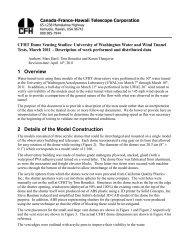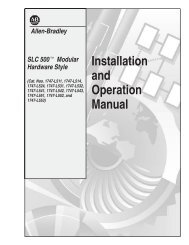Documentation [PDF] - Canada France Hawaii Telescope ...
Documentation [PDF] - Canada France Hawaii Telescope ...
Documentation [PDF] - Canada France Hawaii Telescope ...
Create successful ePaper yourself
Turn your PDF publications into a flip-book with our unique Google optimized e-Paper software.
The stellar color-color tracks of the four fields are remarkably similar. No color offsets can be measured<br />
between D1, D2, D3 and D4. This is illustrated on Fig. 43. It shows a superimposition of the (u ∗ −<br />
g)/(g − r) and (g − r)/(r − i) color-color plots for the four D-85 stacks together.<br />
5.3.2 Internal photometric errors<br />
The internal errors have been measured by comparing the photometry of common sources in the D-25<br />
and D-85 stacks. The D-25 and D-85 parent samples comprise all source pairs listed in the merged<br />
catalogues of the four Deep fields. The selected sources must have magnitudes measured in all filters<br />
(no objects with magnitude/mag_err = 99.0 in any u ∗ , g, r, i, y and z filters, for both the D-25 and D-85<br />
catalogues), with a SExtractor extraction flag FLAGS=0 (objects with good photometry) and a Terapix<br />
object flag=1 or 0 (i.e. stellar or extended sources, only non-saturated objects in non-masked regions).<br />
Only sources fainter than u ∗ , g=20.5 and r, i, y, z=19.5, and brighter than the D-25 80% completeness<br />
limit of extended sources are selected. This cut ensures the homogeneity and completeness of the D-25<br />
and D-85 populations.<br />
The internal photometric errors are derived from the distributions of magnitude differences of source<br />
pairs between the D-25 and D-85 catalogues, D25–D85, as a function of D-25 magnitudes. The analysis<br />
are carried out in three magnitude ranges, for all filters, and after a 3-σ clipping over the distributions of<br />
magnitude differences. The statistics use the MAG_AUTO magnitudes to derive first the median and mean<br />
systematic magnitude offsets between D-25 and D-85, then the mean scatter, based on the rms. We<br />
verified that the median systematic offset is randomly distributed around zero and never exceeds 0.013<br />
mag., for all sub-samples.<br />
The distributions are then fitted by a Gaussian, which gives the FWHM of the mean magnitude difference<br />
of cross-identified sources in D-25 and D-85. The mean internal photometric error is then defined as<br />
σ D25−D85 =FWHM/2.35. We checked that the error estimate based on the Gaussian fitting is very close<br />
to the rms errors. The results are summarized in Table 22. Overall, they look very similar to the Wide<br />
survey, when sources with same signal-to-noise ratio are compared.<br />
We use the results quoted in Table 22 to compute the photometric errors listed in the summary Tables 18<br />
and 19. The internal photometric errors are the mean values of the three magnitude ranges. This is a<br />
reasonable but probably optimistic estimate because it does not take into account there are many more<br />
faint than bright objects. Note that these results are valid for both stellar and extended sources.<br />
In contrast with the Wide survey, we do not have many sources in common between CFHTLS and SDSS<br />
in D2 and D3 to estimate accurately external errors. In addition, we do not have any common sources at<br />
all for D1 and D4. However taking into account the statistics for the internal errors and the remarkable<br />
consistency of the results with the Wide survey, conclusions for the Wide survey apply equally: we<br />
consider the following errors are reasonably accurate and conservative estimates of the rms photometric<br />
errors over a rather broad magnitude range of the CFHTLS Deep survey down to the 80% completeness<br />
limit (details in Table 22):<br />
• 5% in u ∗ ; 3% in g, r and i/y, 4% in z .<br />
For faint sources beyond the 80% completeness limit, photometric errors rise by a factor of ∼ 2 in all<br />
bands with respect to the magnitude range quoted above and in Tables 18 and 19.<br />
77


![Documentation [PDF] - Canada France Hawaii Telescope ...](https://img.yumpu.com/26965302/89/500x640/documentation-pdf-canada-france-hawaii-telescope-.jpg)









